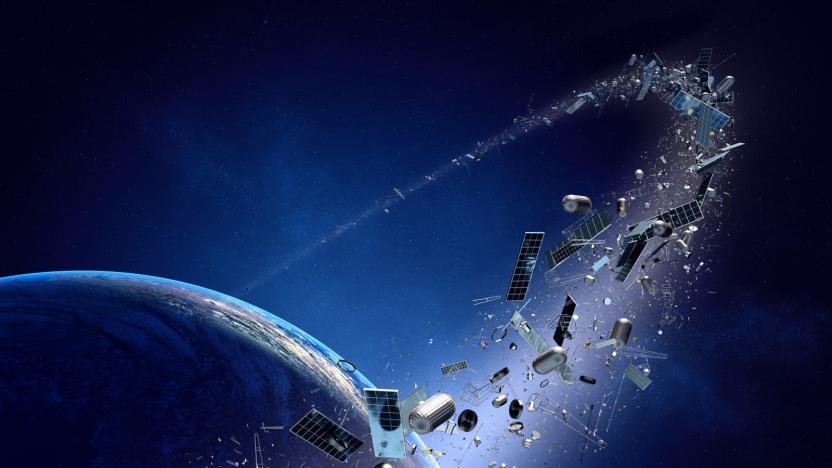spacedebris
Latest

Chinese scientists unveil plan to zap space junk with orbital lasers
There have been more than a few proposals for eliminating space junk, such as grabbing it, gobbling it and blasting it from Earth. The latest idea, however, may be the most dramatic... and the most effective. Chinese researchers have successfully simulated an orbital laser station that would zap small debris (under 4 inches long). The system would zap targets with 20 bursts of light per second for 2 minutes, either deflecting the junk out of harm's way or sending it to a fiery end in the atmosphere.

Watch 58 years of space debris appear in 1 minute
You probably know that the proliferation of space junk is a real problem, but we won't blame you if you have a tough time wrapping your head around the concept. There are roughly 20,000 fragments up there, after all. However, university lecturer Stuart Grey is willing to help. He recently posted a 1-minute video that shows the accumulation of junk from 1957, when Sputnik first flew, through to 2015. As the clip shows, the amount of debris grows in fits and starts. While there were several thousand objects for quite a while, missile tests and satellite collisions added thousands more fragments to the mix.

Scientists built a spacecraft that converts junk to fuel
It turns out that the sky is full of space debris, which poses a threat to craft and satellites orbiting Earth. A team of scientists at Tsinghua University in Beijing, China have come up with a way to remedy this. They've developed a spacecraft that collects the debris in a wide-cast net and uses it as fuel to propel itself forward. This technically means it could keep cleaning forever, unless an unforeseen event brings its efforts to an untimely end. Lasers have been developed for eliminating larger pieces of space junk, however aren't designed for smaller bits that are harder to locate and track. That's where Lei Lan and her team come into the picture.

Space junk collision scare forced ISS crew to evacuate
The ISS crew sure had a rough morning yesterday: a piece of an old Russian satellite came hurtling towards them, and the team didn't have enough time to move the station out of the way. Since they only had an hour and a half to spare, the crew chose to seal off modules to contain possible damage and to lock themselves inside a Soyuz spacecraft. That way, they could abandon the ISS if needed and wouldn't have to desperately scour the near-Earth environment for ways to come back home. That was the fourth time in the station's history that its crew had to move to a Soyuz for safety.

Lockheed Martin to track space junk from the Australian Outback
In the movie Gravity, masses upon masses of floating debris hurtled through space at alarming speeds and collided with the heroine's space shuttle, killing her crew. Space junk isn't just something made up for the movies, though -- it's a real issue that's costing space agencies a whole lotta money. As such, Lockheed Martin has teamed up with Australian company Electro Optic Systems to build a space object tracking facility in western Australia, which the latter has been planning for years. While the U.S. Air Force's debris-tracking Space Fence (also developed by Lockheed Martin) uses radar systems, this one will use an optical technology like those found in telescopes to zoom in on objects, and lasers to calculate their speed and distance from Earth.

UK engineers developing harpoon that could help space junk meet a fiery end
Sure, we can pull space junk out of orbit with lasers or use it to cobble together new satellites, but if engineers at space firm Astrium UK have their way, space trash could be disposed of with the help of harpoons. Currently in a conceptual stage, the system is designed to shoot defunct satellites or other debris with a harpoon mounted on a "chaser satellite" and use a tethered propulsion pack to send the rubbish in an atmospheric descent where it'll burn up. Since the projectile could shoot straight through targets and result in even more garbage, it's been fashioned with a crushable portion to reduce its speed upon impact. There's no concrete word on when the outfit's solution might be put in action, but they'll present their work on Wednesday at the 63rd International Astronautical Congress in Naples (Italy, not Florida, mind you). If you can't wait to see the harpoon at work, head past the break to catch tests of an Earth-based prototype.

DARPA's new Space Surveillance Telescope will keep our satellites safe from interstellar debris
What's that in the sky? A bird? A plane? Oh, it's just some junk floating around in space, posing major threats to our military's spy satellites. To help keep an eye on it, engineers at DARPA, MIT and the Air Force have unleashed a new $110 million telescope that's been in the works for nine years now. The new Space Surveillance Telescope (SST) is capable of delivering wide-angle views of the Earth's firmament thanks to a curved CCD. This allows for a massive 3.5m aperture and f/1.0 exposure settings, capturing more light in a day that your average scope can in a week. As part of the Air Force's Space Surveillance Network (SSN), the telescope's primary task will be to look out for any microsatellites, meteors or other alien droppings moving at the same speed at which the Earth rotates. The system developed its first images earlier this year and the Air Force may eventually place SSTs all over the world, creating a 360-degree surveillance blanket and going a long way toward keeping our spycraft warm, cozy, and safe from galactic hazards.

In lasers we trust: NASA researches 5kW galactic trash disposal system
Space junk is a growing problem -- 200,000 pieces and counting -- and as the amount of earth's orbital debris increases, so does the chance some satellite will be involved in a cosmic collision. As this would cause much gnashing of teeth and woe for the affected terrestrial parties, some researchers from NASA's Ames Research Center have pitched the idea of moving said junk with a laser -- once again proving that everything's better with lasers. The idea is to use a 5kW ray, likely similar to the one we've got at the Starfire Optical Range, to slow our galactic garbage -- perhaps slowing it down enough to burn it up in earth's atmosphere. Current estimates say such a laser could migrate ten pieces of junk a day, which gives us the promise of a future with neat and tidy skies.

Australians develop space junk laser tracking system, still can't track space jams
Australian company Electric Optic Systems has announced its developed a laser tracking system which will be able to stop space junk -- discarded debris in orbit around the earth, of which there is currently over 200,000 pieces larger than 1cm -- from colliding with satellites and spacecraft. The new laser system is more precise than previous radars specifically because of its ability to track debris that is small, which can still cause major problems if encountered. Using a 3.5 million dollar grant from the Australian government, the company developed the system which it says will ultimately work best as a network.

The Professor: GM's new old engine tech, moon mirrors, the dangers of space war debris
The Professor rounds up a handful of interesting and informative gadget-related science stories from the week and presents them in an easily digestible liquid form. Having trouble keeping your fingers, thumbs, or eyeballs on the pulse of modern science? Do you find yourself in the throes of panic due to misunderstandings in molecular goings-on? Did the latest aircar, split atom, or robotic insectoid go buzzing over your head before you had time to ready a response? Don't worry friends, The Professor is here to help. Though not an actual scientist, professor, or even a college graduate, he can help guide you through the cascading, complicated, and spasmodic visionary vistas of human invention and achievement as smoothly as a hot knife descending into softened butter.





